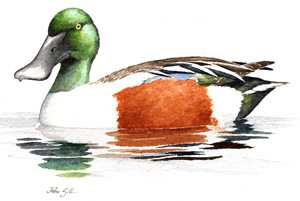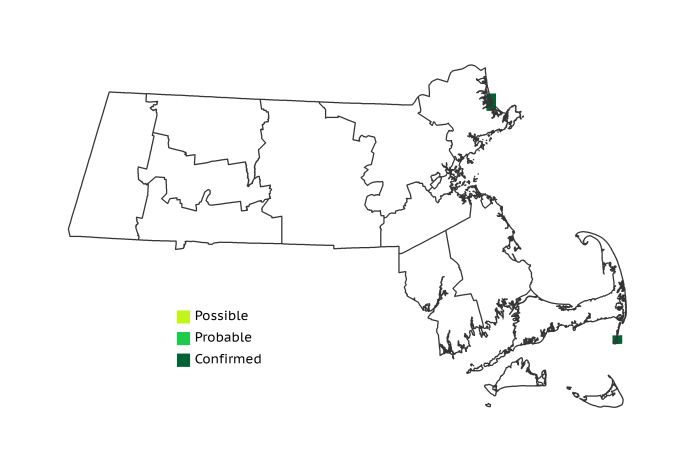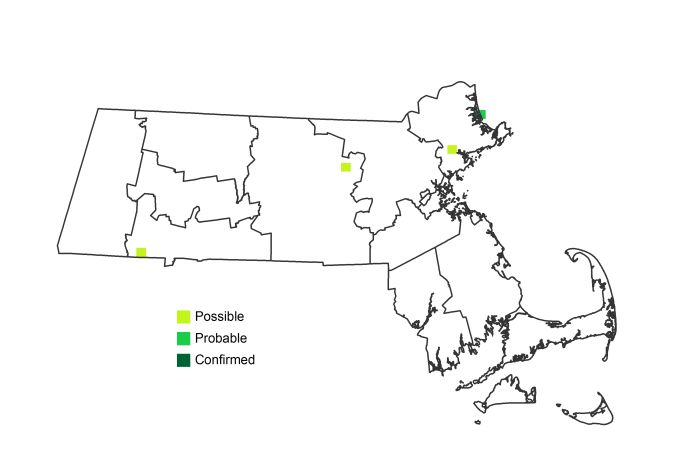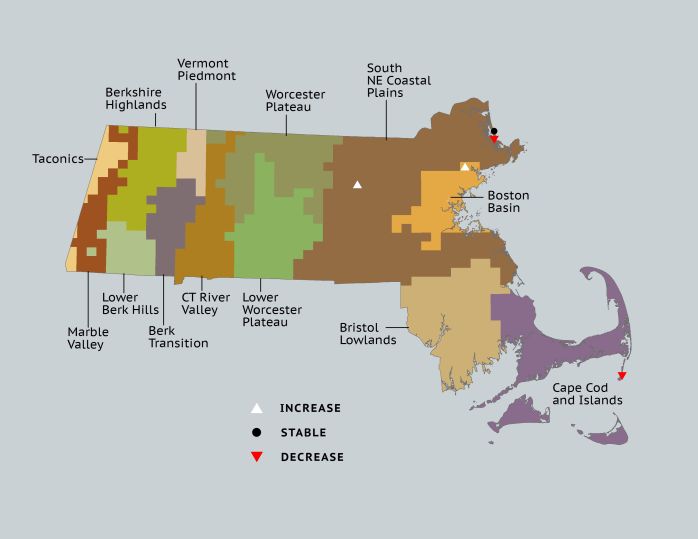Find a Bird
Northern Shoveler
Anas clypeata

Very local, trend not established
“It bears no close resemblance to any other bird.” Edward Howe Forbush, Birds of Massachusetts
The striking plumage of the male Northern Shoveler notwithstanding, this species at any age or of either gender is easily distinguished from other waterfowl by its impressive bill. This highly specialized tool allows shovelers to filter tiny invertebrates out of the water column, giving them access to a food source that some other ducks cannot as effectively exploit. Shovelers breed primarily in the “prairie pothole” regions of the western U.S. and Canada and spend their winters along the eastern seaboard, but this species has also occasionally bred in small numbers in our Commonwealth.
Historic Status
Despite its rarity as a breeder, the Northern Shoveler has nonetheless long been in the sights of hunters in Massachusetts. William Peabody described the bird in 1839 as “one of the greatest luxuries of the table,” and “sometimes found in the Boston market, brought from the ponds in the vicinity.” Forbush, unable to confidently put a quantitative analysis together for the species, in 1925 declared it “formerly less rare” in New England, and Joel Asaph Allen opined in 1878 that “It was formerly, judging from its present breeding range in the interior, a frequent summer resident.”
Atlas 1 Distribution
Shovelers were rare but nonetheless present as Bay State breeders through Atlas 1. Most of the breeding activity was focused in areas where they were also most often seen (and hunted) during their migration. The Confirmed results of their breeding activity in Atlas 1 amounted to 2 occupied blocks at Parker River Wildlife Refuge and another Confirmation on South Monomoy Island off Cape Cod. The locations of these birds suggest that they may have been migrants that decided to remain in Massachusetts after the hunting season was over, having found suitable habitat during the long trip north.
Atlas 2 Distribution and Change
There were no breeding Confirmations of Northern Shovelers during Atlas 2, although birds were present during Safe Dates at four scattered locations in the state. Of these, the Probable birds recorded at Parker River National Wildlife Refuge were the most likely to have been actual breeders, as shovelers have been Confirmed at the Refuge in years past.
Atlas 1 Map

Atlas 2 Map

Atlas Change Map

Ecoregion Data
Atlas 1 | Atlas 2 | Change | ||||||
Ecoregion | # Blocks | % Blocks | % of Range | # Blocks | % Blocks | % of Range | Change in # Blocks | Change in % Blocks |
Taconic Mountains | 0 | 0.0 | 0.0 | 0 | 0.0 | 0.0 | 0 | 0.0 |
Marble Valleys/Housatonic Valley | 0 | 0.0 | 0.0 | 0 | 0.0 | 0.0 | 0 | 0.0 |
Berkshire Highlands | 0 | 0.0 | 0.0 | 0 | 0.0 | 0.0 | 0 | 0.0 |
Lower Berkshire Hills | 0 | 0.0 | 0.0 | 1 | 3.2 | 25.0 | 0 | 0.0 |
Vermont Piedmont | 0 | 0.0 | 0.0 | 0 | 0.0 | 0.0 | 0 | 0.0 |
Berkshire Transition | 0 | 0.0 | 0.0 | 0 | 0.0 | 0.0 | 0 | 0.0 |
Connecticut River Valley | 0 | 0.0 | 0.0 | 0 | 0.0 | 0.0 | 0 | 0.0 |
Worcester Plateau | 0 | 0.0 | 0.0 | 0 | 0.0 | 0.0 | 0 | 0.0 |
Lower Worcester Plateau | 0 | 0.0 | 0.0 | 0 | 0.0 | 0.0 | 0 | 0.0 |
S. New England Coastal Plains and Hills | 2 | 0.7 | 66.7 | 2 | 0.7 | 50.0 | 0 | 0.0 |
Boston Basin | 0 | 0.0 | 0.0 | 1 | 1.8 | 25.0 | 1 | 1.8 |
Bristol and Narragansett Lowlands | 0 | 0.0 | 0.0 | 0 | 0.0 | 0.0 | 0 | 0.0 |
Cape Cod and Islands | 1 | 0.7 | 33.3 | 0 | 0.0 | 0.0 | -1 | -0.8 |
Statewide Total | 3 | 0.3 | 100.0 | 4 | 0.4 | 100.0 | 0 | 0.0 |



